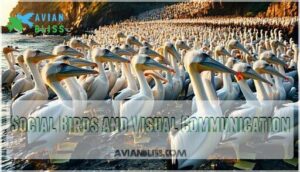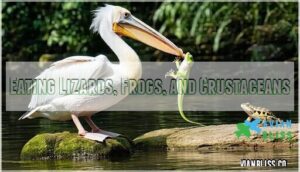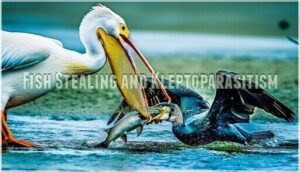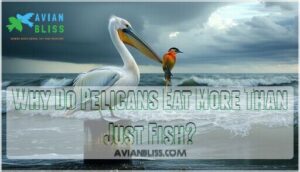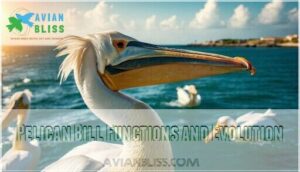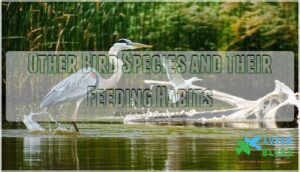This site is supported by our readers. We may earn a commission, at no cost to you, if you purchase through links.
 Pelicans are opportunistic predators with massive throat pouches capable of swallowing anything that fits, from pigeons to seagull chicks. When fish become scarce due to environmental changes or seasonal variations, these adaptable hunters won’t pass up easy protein sources like young waterfowl or urban birds.
Pelicans are opportunistic predators with massive throat pouches capable of swallowing anything that fits, from pigeons to seagull chicks. When fish become scarce due to environmental changes or seasonal variations, these adaptable hunters won’t pass up easy protein sources like young waterfowl or urban birds.
Sure, they’d rather stick to fish, but when times get tough, pelicans aren’t picky. This flexible approach to dining has let them flourish on six continents, even if it catches bird enthusiasts off guard when they witness these supposed seafood specialists gulping down a pigeon.
Table Of Contents
- Key Takeaways
- Pelican Characteristics and Behavior
- Do Pelicans Eat Other Birds?
- Pelican Feeding Habits and Diet
- Why Do Pelicans Eat More Than Just Fish?
- Pelican Bill Functions and Evolution
- Pelican Conservation and Threats
- Other Bird Species and Their Feeding Habits
- Geographic Distribution of Pelicans
- Why Do Pelicans Engage in Unique Behaviors?
- Frequently Asked Questions (FAQs)
- Do Pelicans eat birds?
- How do Pelicans eat fish?
- Do Pelicans eat gulls?
- Do Pelicans digest their prey?
- How do Pelicans protect themselves from predators?
- Do pelicans have predators?
- Do pelicans eat live animals?
- Why do pelicans swallow fish whole?
- Will a pelican eat a seagull?
- Why do pelicans hit the water with their wings?
- Conclusion
Key Takeaways
- Pelicans are opportunistic predators who expand their diet beyond fish when environmental pressures or food scarcity occur, with documented cases showing up to 7% of their diet can consist of other birds during certain periods.
- Survival drives dietary flexibility as these adaptable hunters target pigeons, ducklings, and seagull chicks when traditional fish populations decline due to seasonal variations, habitat destruction, or climate change impacts.
- Urban environments increase bird predation because reduced escape cover and abundant prey make it easier for pelicans to catch smaller birds, with studies showing up to 4% of urban pelican stomach samples containing avian prey.
- Their massive throat pouches enable versatile hunting as these expandable structures can accommodate any prey that fits, from fish to birds, demonstrating millions of years of evolutionary adaptation that prioritizes protein acquisition over dietary preferences.
Pelican Characteristics and Behavior
Pelicans possess striking adaptations that make them efficient aquatic predators, from their iconic expandable throat pouches to their powerful webbed feet.
Pelicans are surprisingly social creatures that work together in fascinating ways. You’ll see them hunting as a team, herding fish into shallow water where everyone gets a meal.
They also have their own language of sorts—those dramatic bill-clapping displays aren’t just for show, but a way to communicate with their flock.
Unique Bill and Throat Pouch
What if I told you that a pelican’s bill isn’t just a fishing tool—it’s actually a marvel of engineering that can stretch to hold three gallons of water and fish? This specialized anatomy features a gular sac (the technical term for their throat pouch) made of incredibly flexible skin.
What makes their unique morphology so striking:
- Pouch as net: The gular pouch expands dramatically to scoop fish and water simultaneously
- Bill strength: Sharp bills pierce through water with remarkable precision during dives
- Drainage system: Specialized muscles contract to expel water while retaining prey
- Temperature control: The pouch helps regulate body heat through blood vessel dilation
It’s wild to think that millions of years of evolution fine-tuned this incredible feeding strategy.
Social Birds and Visual Communication
Picture a bustling seabird colony where pelicans communicate through an intricate ballet of bill-clapping, pouch-stretching, and synchronized head movements—it’s like watching nature’s own version of social media in action.
All this social interaction builds intricate pecking orders that actually help pelicans work together when it’s time to breed.
Young birds watch and learn from these visual cues, picking up crucial skills like defending their turf and that distinctive wing-hitting behavior that keeps them alive in the cutthroat world of coastal living.
Swimming Ability and Webbed Feet
Those webbed feet aren’t just for show—they’re like built-in swim fins that turn pelicans into surprisingly agile underwater athletes. Each foot features three forward-facing toes connected by tough webbing, creating powerful paddles for underwater propulsion. These aquatic birds use their webbed feet for precise buoyancy control, allowing them to hover at ideal depths while hunting. Their swimming efficiency reaches impressive speeds during predatory behavior, with sleek bodies cutting through water as their feeding techniques target fish below.
Key swimming adaptations include:
- Webbed toe structure: Three-toed paddles with reinforced webbing for greatest thrust
- Buoyancy mastery: Air-filled bones help control diving depth during hunting techniques
- Propulsion power: Strong leg muscles drive rapid underwater acceleration
- Aquatic adaptation: Waterproof feathers and specialized glands aid extended swimming sessions
Playful and Gregarious Nature
When you watch a group of pelicans together, you’re witnessing nature’s most boisterous social club in action. These opportunistic feeders display striking cooperative behavior through synchronized swimming and group fishing expeditions.
Their playful activities include bill-clapping contests and splashing competitions that strengthen colony dynamics. This group harmony isn’t just fun—it’s an essential survival strategy that enhances their predatory behavior and diet variation success rates.
Do Pelicans Eat Other Birds?
Yes, pelicans do eat other birds, though it’s not their preferred meal. When fish become scarce or opportunities arise, these opportunistic hunters will snatch up pigeons, ducklings, and other small birds that venture too close to the water’s edge.
Preying on Small Birds
Scientific evidence shows that pelicans actually do hunt small birds, with some breeding colonies seeing this happen up to 7% of the time. When fish get hard to find, pelicans switch gears and start going after other birds. Young gulls, ducklings, and baby birds that can barely fly become easy targets.
Here’s how they do it:
- Quick, powerful strikes with their bills that can actually impale smaller birds before drowning them
- Raiding nests when they spot vulnerable chicks
- Making a real dent in local bird populations—stomach content studies show small birds can make up 3-8% of what they’re eating
In cities, this hunting behavior has gotten even more intense. Pelicans have basically become these surprisingly effective opportunistic predators.
Eating Birds in Urban Environments
Urban environments have created unexpected opportunities for pelican predatory behavior. In cities, these opportunistic feeders target pigeons and ducklings when traditional fish sources become scarce. Studies show up to 4% of urban pelican stomach samples contain other birds.
Brown pelicans, however, primarily consume fish and marine invertebrates. Anthropogenic food sources and reduced escape cover make urban bird predation more successful, contributing to human-wildlife conflict and measurable community effects on local waterbird populations.
Nocturnal Bird-Hunting Behavior
Most people think pelicans are gentle fish-eaters, but these feathered giants have a dark secret that emerges after sunset. Under lunar influence, their nocturnal bird-hunting behavior reveals cunning predatory behavior using enhanced sensory adaptations. When darkness provides cover, pelicans eat other birds through stealthy hunting techniques that disrupt the sleep patterns of unsuspecting prey:
- Silent aerial attacks targeting roosting songbirds with precision strikes
- Nighttime predation exploiting reduced avian defense mechanisms in sleeping birds
- Enhanced night vision allowing pelican feeding behavior to adapt beyond daylight fish consumption
Pelican Feeding Habits and Diet
Pelicans don’t just stick to their famous fish-catching routine—they’re surprisingly adaptable hunters with a menu that changes based on what’s available.
When fish populations drop or environmental pressures mount, these opportunistic birds expand their diet to include crustaceans, amphibians, and yes, even smaller birds.
Primary Fish Diet
Fish might be the star of the show, but pelicans aren’t exactly picky eaters with regard to their aquatic menu. These birds target various fish species, from small minnows to larger carp, adapting their primary fish diet based on seasonal availability.
Their nutritional needs drive this diet diversity, with feeding frequency increasing during the breeding season. Pelican feeding habits reflect nature’s sustainable diet approach—they’ll switch between different fish populations to avoid overexploiting any single species, so their dietary variation aids both their survival and ecosystem balance.
Eating Lizards, Frogs, and Crustaceans
When fish aren’t swimming by, pelicans turn into opportunistic diners who’ll snap up whatever crawls, hops, or scuttles within reach. These dietary adaptations showcase their striking flexibility as opportunistic feeders:
- Lizard hunting becomes second nature when reptiles bask near water
- Amphibian consumption provides essential protein during fish shortages
- Crustacean nutrition offers calcium-rich alternatives that foster bone health
This diet variation demonstrates how pelicans thrive across diverse ecosystems.
Scavenging and Opportunistic Eating
Pelicans demonstrate remarkable diet plasticity when facing seasonal shortages. These opportunistic eaters adapt quickly to human impact on their environments, with urban scavenging becoming increasingly common. During resource bottlenecks, their opportunistic feeding extends beyond typical prey. Notably, they’ll also consume small reptiles and amphibians when available.
| Food Source | Frequency During Scarcity | Adaptive Advantages |
|---|---|---|
| Urban refuse/garbage | 18% of diet | Energy conservation during droughts |
| Discarded seafood | 32% spike in spring | Maintains breeding success rates |
| Dead animals/carrion | 7% of foraging observations | Reduces energy expenditure |
| Human food handouts | 12% of urban encounters | Aids colony persistence |
| Non-fish aquatic prey | 24% diet shift | Prevents starvation episodes |
Pelicans prove that flexibility beats specialization when the environment gets tough.
Fish Stealing and Kleptoparasitism
Imagine this: a pelican spots another bird with a fresh catch and thinks, "Why work when you can steal?" This klepto strategy is called kleptoparasitism, and these pirate pelicans have mastered it. They’ll target cormorants, gulls, and even fellow pelicans who’ve done the hard work of fishing.
It’s pure energy gain through resource competition—why dive when you can just snatch a stolen meal? These opportunistic feeders understand social dynamics perfectly, turning predatory behavior into an art form.
- Target Selection: Pelicans specifically choose birds carrying large fish that are difficult to swallow quickly
- Timing Masters: They strike when victims are most vulnerable—during fish manipulation or swallowing attempts
- Reciprocal Theft: Gulls and other seabirds also steal from pelicans, creating complex food source battles
Why Do Pelicans Eat More Than Just Fish?
When fish populations dwindle or environmental conditions shift, pelicans don’t simply go hungry—they adapt by expanding their menu to include smaller birds, crustaceans, and even amphibians.
Pelicans have spent millions of years perfecting this flexibility, turning them into opportunistic hunters that can roll with the punches when ecosystems shift and food gets scarce.
Adaptation to Environmental Changes
Nature doesn’t hand out participation trophies—when the environment shifts, you either adapt your menu or risk going hungry. Pelicans demonstrate striking behavioral plasticity through dietary shifts when facing habitat loss and pollution.
What makes pelicans tough survivors? They can switch up their diet on the fly when their usual hunting grounds disappear or get polluted.
When the environment throws them curveballs, these birds don’t just adapt—they completely change how they hunt and what they eat to stay alive.
Availability of Food Sources
Ever notice how a hungry pelican becomes nature’s greatest opportunist? When fish population decline hits their usual hunting grounds, these opportunistic eaters don’t just sit around waiting. Their dietary flexibility benefits kick in as they scout for alternative prey options.
During seasonal food scarcity, you’ll find them adapting their avian diet in surprising ways:
- Urban food access: City pigeons become easy targets
- Backup protein sources: Small ducks and seabirds fill the gap
- Seasonal adjustments: Winter drives them toward accessible prey
- Environmental shifts: Pollution forces menu changes
- Competition pressure: Limited food sources mean expanding options
When food is scarce, prey availability determines survival—and pelicans won’t hesitate to diversify.
Evolutionary Advantages of Omnivory
Beyond simply surviving, omnivorous pelican feeding habits offer important evolutionary advantages. Dietary shifts allow these birds to exploit multiple ecological niches during environmental instability.
Studies reveal that when birds eat everything, they actually create more stable food webs. Sure, these omnivorous species might not branch into new species as quickly, but their flexible eating habits keep ecosystems balanced when things get unpredictable.
Pelican Bill Functions and Evolution
The pelican’s iconic bill isn’t just a fishing tool—it’s a Swiss Army knife that evolved for multiple survival functions.
From catching prey to cooling down on hot days, this notable appendage acts as both weapon and thermostat in the bird’s daily life.
Catching and Draining Water
That massive throat pouch isn’t just for show—it’s a precision-engineered water filtration system that would make any engineer jealous. When pelicans dive, their Pouch Mechanics create perfect Hydrodynamics for capturing prey. Here’s how Efficient Drainage works in their hunting techniques:
- Pouch expands to trap fish and gallons of water
- Water Expulsion occurs through bill manipulation and gravity
- Prey Retention keeps fish secure during drainage
- Complete predatory behavior in birds sequence takes mere seconds
These Pelican feeding habits showcase evolution’s engineering brilliance.
Defense Mechanisms and Threat Display
If you think a flock of pelicans is just a peaceful gathering, wait until you see them team up and turn into a feathery security squad. When predators threaten their colony defense systems, these birds deploy impressive threat signals through synchronized bill-clapping and aggressive posturing.
Their agonistic behavior includes dramatic pouch-stretching displays that warn intruders away from vulnerable chicks. This survival mechanism showcases how ecological factors shaped their predatory instincts beyond simple feeding.
Feeding Chicks and Regurgitating Food
When chick feeding time arrives, parent pelicans transform into living lunch boxes, delivering meals through one of nature’s most intimate—and admittedly gross—dining experiences. This Chick Regurgitation process showcases noteworthy Parental Care, as adults carefully bring up partially digested fish from their stomachs. The Food Digestion begins in the parent’s system, making nutrients more accessible for developing young.
Pelican feeding behavior during chick-rearing involves these fascinating aspects:
- Feeding Frequency occurs multiple times daily, with parents responding to persistent begging calls
- Nutritional Needs are met through protein-rich regurgitated fish, supporting rapid growth
- Chicks insert their entire heads into the parent’s throat pouch during feeding
- Parents select specific fish sizes appropriate for their offspring’s developmental stage
- The regurgitation process can last several minutes per feeding session
This intimate dietary habits system ensures pelican chicks receive choice nutrition during their most vulnerable weeks, demonstrating how evolution perfected these striking food sources delivery methods.
Thermoregulation and Cooling
Pelicans don’t just use their pouches for catching fish—they’ve turned them into personal air conditioners. When temperatures soar, they engage in gular fluttering—rapidly vibrating their throat pouches to promote evaporative cooling. The pouch blood vessels dilate, allowing heat to escape through panting mechanisms while they seek shade for additional thermoregulation.
| Cooling Method | How It Works |
|---|---|
| Gular fluttering | Rapid pouch vibration increases airflow |
| Panting mechanisms | Open-bill breathing releases body heat |
| Pouch blood vessels | Dilation allows heat transfer to air |
| Shade seeking | Behavioral adaptation to environmental changes |
Pelican Conservation and Threats
Pelican populations face mounting pressures from human activities and environmental changes that directly impact their predatory behaviors.
These conservation pressures push pelicans toward new hunting strategies. When their usual fish stocks dwindle and coastal wetlands shrink, they adapt by targeting whatever prey they can find, even other birds.
Habitat Destruction and Pollution
Picture this: you’re watching a pelican dive gracefully for fish when industrial waste and plastic debris are quietly poisoning their coastal home. Development bulldozes nesting sites, cramming these birds into smaller spaces. Agricultural runoff creates dead zones where fish disappear, leaving pelicans scrambling for food.
- Oil spills coat their feathers, destroying waterproofing and causing hypothermia
- Plastic ingestion blocks digestive systems when pelicans mistake debris for fish
- Coastal development eliminates traditional roosting and breeding colonies
All this pressure changes everything—how pelicans hunt, what they eat, where they go.
Climate Change Impacts
Climate change hits pelicans like a slow-motion tsunami, reshaping everything from where they nest to what swims beneath the waves they call home. Rising temperatures trigger habitat degradation and migration pattern shifts that leave colonies scrambling to adapt.
When climate change impacts ocean currents and temperatures, prey availability plummets—fish populations crash or relocate entirely. This environmental stress creates a domino effect: breeding success rates nosedive as parents struggle to find adequate nutrition.
Extreme weather events compound these challenges, destroying nesting sites and forcing pelicans into unfamiliar territories where food is scarce.
DDT and Pesticide Effects
DDT’s toxic legacy created a nightmare scenario for brown pelicans during the 1960s. This persistent pesticide caused catastrophic eggshell thinning—shells became 30% thinner than normal, leading to widespread nest failures as eggs crushed under parental weight. California pelican colonies collapsed by over 90%, with breeding success plummeting to just 0.004 fledglings per nest. Sublethal effects included endocrine disruption and altered breeding behaviors. While population recovery followed DDT’s 1972 ban, conservation concerns persist as residues still appear in pelican tissues decades later, demonstrating pollution’s lasting environmental impacts on pelicans.
- Crushed eggs littering abandoned nests across once-thriving colonies
- Parent birds unknowingly destroying their own offspring through normal incubation
- Tissue samples revealing toxic concentrations up to 84.4 ppm in muscle tissue
- Empty rookeries where thousands of pelicans once gathered to breed
Protected Species and Conservation Efforts
After decades of devastating population crashes, conservation heroes stepped in with a game-changing rescue mission. Today, many pelican species enjoy protected status under federal wildlife laws, while habitat restoration projects rebuild key nesting sites.
Fishing regulations now prevent overharvesting of prey fish, and pollution prevention measures tackle toxic runoff.
Education campaigns help communities understand how their actions affect pelican populations, creating a network of local conservation advocates working to secure these birds’ future.
Other Bird Species and Their Feeding Habits
Pelicans aren’t the only birds with surprising dietary habits that challenge our expectations.
From great blue herons stalking unsuspecting prey to kelp gulls attacking whales, the avian world is full of unexpected feeding behaviors that reveal nature’s endless adaptability.
Great Blue Herons and Stalking Prey
Great blue herons turn wetland hunting into an art form, standing motionless for hours like feathered statues before striking with lightning speed. Their Heron Hunting Tactics involve perfect camouflage and stealth as they wade through Marsh Ecosystem Dynamics, competing with pelicans for prey species.
Unlike pelicans, which eat other birds, herons use dagger-like bills and patience-driven hunting techniques to master their predatory instincts.
Turkey Adaptation to Human Environment
Wild turkeys have become the definitive urban survivors, trading their woodland buffets for suburban smorgasbords of pet food, garbage, and garden treats. Their striking environmental adaptation showcases how species modify their foraging behavior when human-provided food becomes abundant.
Here’s how these birds thrive in urban environments:
- Raiding bird feeders and pet food bowls left outdoors
- Scavenging through garbage bins for discarded food scraps
- Grazing on landscaped lawns and garden vegetation
- Adapting feeding schedules to avoid peak human activity
- Learning to navigate suburban turkey habitats despite turkey-vehicle collisions
But this shift comes with trade-offs—while turkeys get easier meals, they also face new health risks from diseases that spread more easily in crowded suburban settings.
Crow Omnivory and Misconceptions
Crows have fooled us all – these black-feathered tricksters aren’t the garbage-gobbling gluttons most people imagine them to be.
Crow diet myths paint them as indiscriminate scavengers, but their crow intelligence diet reveals discerning food choices. Urban crow feeding involves selective scavenging habits, targeting protein-rich sources when food is scarce, much like how pelicans eat other birds as opportunistic predators.
Kelp Gull Whale-Eating Behavior
You might think of seagulls as harmless scavengers, but kelp gulls have developed a shocking taste for whale flesh. These opportunistic predators attack living southern right whales, landing on their backs to gouge out skin and blubber with powerful beaks.
When food is scarce, their predatory instincts drive this survival mechanism, creating wounds up to half a meter wide. This marine ecosystem impact shows how scavenging specializations can evolve into aggressive feeding behaviors, demonstrating evolutionary adaptations that parallel why pelicans eat other birds during resource shortages.
Geographic Distribution of Pelicans
Pelicans inhabit diverse aquatic environments across six continents, from North America’s coastlines to Australia’s wetlands.
You’ll find these adaptable seabirds establishing massive breeding colonies in coastal areas, lakes, and rivers where fish populations can sustain their opportunistic feeding behaviors.
Global Range and Habitat
From the Arctic Circle to tropical coastlines, these notable seabirds have claimed territory across nearly every corner of our planet. Pelicans showcase striking habitat diversity, thriving in both coastal wetlands and inland freshwater systems.
Their global distribution spans multiple ecosystems, adapting to various ecological niches:
- Saltwater environments along ocean coastlines worldwide
- Freshwater lakes and rivers across temperate zones
- Estuarine systems where rivers meet the sea
- Island breeding colonies in remote archipelagos
But these birds face real challenges. Pollution chokes their waterways, while development eats away at the places they’ve called home for generations.
Migration Patterns and Breeding Grounds
Nature’s wanderers don’t follow human schedules. American White Pelicans demonstrate Migration Triggers that span February to March for northbound journeys and October to November southward. These impressive birds establish breeding seasons from April through September, showing moderate Breeding Fidelity with 50% returning to previous sites.
Colony Dynamics reflect complex Habitat Selection patterns:
- Eastern populations cross the Continental Divide toward Gulf states
- Western flocks migrate to Pacific coastal regions
- Some individuals travel up to 600 kilometers between colonies annually
- Northern breeders require ice-free waters, driving migration timing
- Climate Impacts increasingly disrupt traditional patterns, affecting conservation efforts and predation cycles
Their breeding grounds feature remote islands and sandbars that pelicans carefully select for prime fish access.
Colonies and Flocking Behavior
Thousands of pelicans gathering in a single colony creates one of nature’s most impressive spectacles—imagine a bustling city where everyone speaks in honks and bill-claps.
These massive colonies aren’t just for show—they’re survival strategies. Social hierarchy determines breeding success, while cooperative hunting increases feeding efficiency.
Some colonies swell to tens of thousands of birds. The payoff? Shared vigilance against predators and a kind of generational classroom where young pelicans learn the ropes by watching their elders hunt and navigate social dynamics.
Why Do Pelicans Engage in Unique Behaviors?
Pelicans exhibit fascinating behaviors that go far beyond simple feeding patterns.
You’ll discover that their wing-hitting, cooperative fishing techniques, and elaborate courtship displays reveal complex social intelligence and adaptive strategies honed over millions of years of evolution.
Plunge Diving and Cooperative Fishing
When brown pelicans spot a school of fish from 60 feet up, they transform into living torpedoes, folding their wings and hitting the water at nearly 40 miles per hour. These hunting techniques showcase striking dive mechanics and prey capture efficiency. Groups coordinate their plunge diving to enhance success rates while managing energy expenditure through strategic feeding behavior.
- Synchronized timing – Multiple pelicans dive simultaneously to prevent fish from scattering
- Depth coordination – Birds target different water levels to cover escape routes
- Recovery spacing – Staggered surfacing reduces competition for captured prey
Wing-Hitting and Splashing
Ever seen a pelican throw what looks like a waterbird tantrum, complete with dramatic wing-slapping and explosive splashing? These aren’t random outbursts—they’re elaborate Splash Hunting Tactics and Cooperative Splash Herding techniques.
When pelican feeding habits involve snatching fish from turbid waters, their Wing-Beating Frequency creates controlled chaos that confuses prey.
These splashing behaviors also serve as Distraction Display Hunting, helping pelicans eat other birds by stunning smaller species through strategic water turbulence.
Visual Displays and Courtship
Picture this: pelicans drop their usual fishing game and turn into total romantics when breeding season hits. They swap their focus from catching dinner to putting on elaborate courtship shows that reveal just how much their behavior can change.
When it’s time to find a mate, pelicans pull out all the stops with four amazing displays:
- Pouch inflation – Males puff up their throat pouches like bright party balloons
- Bill-clapping performances – They create rhythmic beats by snapping their beaks together
- Plumage display – Their feathers burst into vivid breeding colors
- Synchronized head swaying – Couples move their heads in perfect harmony
All this fancy footwork pays off by building the strong partnerships they need to raise their young successfully.
Frequently Asked Questions (FAQs)
Do Pelicans eat birds?
Yes, pelicans eat other birds, though it’s not their primary diet. These opportunistic predators will consume smaller bird species like pigeons and ducklings when fish become scarce, demonstrating flexible foraging behavior that helps them survive environmental changes.
How do Pelicans eat fish?
Fish capture relies on the pelican’s expandable throat pouch. Pelicans dive headfirst, opening their bills underwater to scoop fish and water into their pouches, which can hold up to 3 gallons.
| Technique | Fish Size | Method |
|---|---|---|
| Plunge diving | Small-medium | Solo aerial strikes |
| Cooperative fishing | Various | Group herding |
| Surface scooping | Small | Bill skimming |
Do Pelicans eat gulls?
Occasionally, these prehistoric-looking birds do consume gulls, particularly during food scarcity when gull vulnerability increases. Pelican aggression toward gulls involves drowning prey underwater before consumption. This intraspecific predation represents their adaptive survival mechanism.
- Dietary overlap creates competition for fish resources
- Predation frequency increases during environmental stress
- Ecosystem impact affects gull population dynamics
- Pelicans eat other birds when traditional prey becomes scarce
Do Pelicans digest their prey?
Like all birds, pelicans possess a highly efficient digestive system designed to extract the greatest nutrition from their prey. Through powerful digestive enzymes and specialized stomach structures, pelicans efficiently break down their prey while filtering out indigestible materials like bones.
The digestion process in birds involves multiple stages, where pelicans lack digestive enzymes to process anything other than fish successfully, making their diet primarily fish-based for best nutrition absorption.
Digestion Stage Process Function
The helpful bacteria in their gut makes digestion work better, but they still can’t break down bones very well.
What they’re really good at is processing entire fish through their amazing digestive setup.
How do Pelicans protect themselves from predators?
Adult pelicans rely on colony defense and mobbing behavior against predators, while strategic camouflage tactics help protect vulnerable chicks.
Their large size and group coordination effectively deter most aerial threats through collective predator evasion strategies.
Do pelicans have predators?
Are these massive water birds easy targets for predators? Adult pelicans face few natural predators due to their impressive size, but juvenile vulnerability leaves young birds exposed to various threats:
- Eagles and other raptors target both eggs and chicks
- Terrestrial mammals like coyotes, cats, and foxes raid nests
- Corvids and gulls opportunistically steal eggs and prey on nestlings
- Human impact remains their greatest threat through habitat destruction
These large birds aren’t usually aggressive unless provoked, relying instead on predator avoidance through colonial nesting and their considerable wingspan for protection.
Do pelicans eat live animals?
Absolutely, pelicans are active predators that regularly consume live animals. You’ll witness them hunting fish, crustaceans, and amphibians like frogs.
Surprisingly, they also prey on smaller birds, including pigeons and ducklings, which they often drown before swallowing whole. This is made possible by their impressive digestive capabilities.
Why do pelicans swallow fish whole?
The pelican’s specialized anatomy makes whole-fish swallowing remarkably efficient. Their expandable throat pouch and flexible esophagus accommodate large aquatic prey, while powerful digestive acids break down bones completely.
It’s a game-changer that lets them grab meals quickly without worrying about prey size—something that gives pelicans a real edge over other seabirds stuck with smaller catches.
Will a pelican eat a seagull?
Surprisingly, pelicans can and do eat seagulls, though it’s not their preferred prey. When fish populations dwindle in coastal ecosystems, these opportunistic predators show considerable pelican aggression toward smaller birds.
Interspecies predation occurs when hungry pelicans encounter vulnerable gulls, turning them into an unexpected feathered feast within complex avian food webs.
Why do pelicans hit the water with their wings?
Through strategic wing-hitting, pelicans create water displacement that stuns and disorients fish, making prey easier to capture. This cooperative hunting technique enhances their predation success through coordinated sensory perception.
- Powerful wing strikes create underwater shock waves that temporarily paralyze small fish
- Multiple pelicans often work together, forming hunting circles to trap schools of prey
- The splashing motion forces fish toward shallow waters where capture becomes simple
Conclusion
Don’t ruffle your feathers over this revelation—pelicans aren’t picky eaters when survival’s on the line. Understanding why pelicans eat other birds reveals nature’s practical side: these adaptable giants prioritize protein over preferences.
When fish become scarce, young birds make convenient meals. This opportunistic behavior showcases evolutionary brilliance, helping pelicans thrive across diverse environments while reminding us that wildlife rarely follows our human expectations about "appropriate" dining habits.
When survival’s on the line, pelicans abandon dietary preferences and turn young birds into convenient protein sources
- https://pmc.ncbi.nlm.nih.gov/articles/PMC6997155/
- https://digitalcommons.unl.edu/cgi/viewcontent.cgi?article=2316&context=icwdm_usdanwrc
- https://idfg.idaho.gov/article/balancing-fish-and-pelican-conservation
- https://abcbirds.org/bird/brown-pelican/
- https://academic.oup.com/najfm/advance-article-abstract/doi/10.1093/najfmt/vqaf067/8225771


